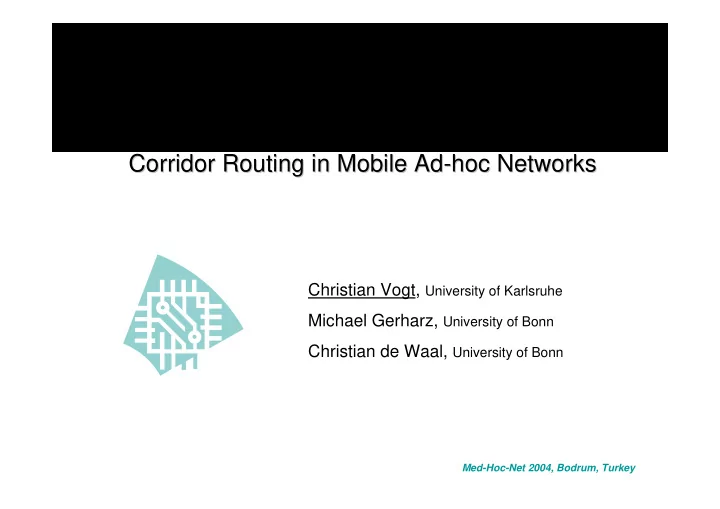

Corridor Routing Routing in Mobile in Mobile Ad Ad- -hoc hoc Networks Networks Corridor Christian Vogt, University of Karlsruhe Michael Gerharz, University of Bonn Christian de Waal, University of Bonn Med-Hoc-Net 2004, Bodrum, Turkey Med-Hoc-Net 2004, Bodrum, Turkey, #1
Overview Overview � Advantages of Multi-Path Routing � Existing Multi-Path Protocols � Corridor Routing � Simulation Results and Analysis � Conclusion and Future Work Med-Hoc-Net 2004, Bodrum, Turkey, #2
Advantages of Multi Multi- -Path Path Routing Routing Advantages of � Bottleneck Circumvention Choosing paths with low traffic � Efficient Bandwidth Usage Disperse traffic over multiple paths � Reduced Destination Discovery Frequency Reducing signaling overhead Med-Hoc-Net 2004, Bodrum, Turkey, #3
Existing Multi Multi- -Path Path Protocols Protocols Existing Ad d- -hoc hoc O On n- -demand demand M Multi ulti- -Path Path A Distance istance V Vector ector Routing Routing , AOMDV D � Disjoint paths � Paths of different length Das, Marina: � Limit on number of routes " On-Demand Multipath Distance Vector Routing in Ad-hoc � Unicast Route Reply Networks ," IEEE ICNP, Nov. 2001 . messages Split plit M Multi ulti- -Path Path R Routing outing , SMR S Gerla, Lee: " Split Multipath Routing with Maximally Disjoint Paths in Ad- hoc Networks ," IEEE ICM, June 2001 . Med-Hoc-Net 2004, Bodrum, Turkey, #4
Corridor Routing Routing Corridor Existing MP Protocols Corridor Routing � Disjoint paths � Paths may overlap overlap � Paths of different length � Paths are minimum minimum-hop � Limit on number of routes � Number of routes unlimited unlimited � Unicast Route Reply � � Broadcast Broadcast Route Reply messages messages Corridor Corridor Source Destination Med-Hoc-Net 2004, Bodrum, Turkey, #5
Destination Discovery Destination Discovery Source Destination Route Request Request message message… … Route Reply Reply message message… … Route Route � is flooded � is regionally flooded into the network regionally broadcasted broadcasted � holds a Hops-to-Source field along the corridor � holds a Hops-to-Destination field � holds a Total-Hops field Med-Hoc-Net 2004, Bodrum, Turkey, #6
Destination Discovery (2) Destination Discovery (2) Source Destination Intermediate router is on a minimum-hop path ⇔ Hops-to-Source + Hops-to-Destination = Total-Hops Med-Hoc-Net 2004, Bodrum, Turkey, #7
Simulation Results Results and Analysis and Analysis Simulation � DSR, AODV, and � Network Simulator 2 Corridor Routing Protocol (CRP CRP) at L3 � 50 Mobile Nodes IEEE 802.11b at L2 50 m Transmission Range 300x60 m 2 Movement Area � VoIP, 12.2 kbps (AMR Codec) ∅ 2 ∼ 7 m / s Movement Speed 60s Call Holding Time 1 ∼ 6 Parallel Calls Med-Hoc-Net 2004, Bodrum, Turkey, #8
Datagram Delivery Ratio Delivery Ratio Datagram Med-Hoc-Net 2004, Bodrum, Turkey, #9
Routing Failure Failure Ratio Ratio Routing Med-Hoc-Net 2004, Bodrum, Turkey, #10
Destination Discovery Frequency Frequency Destination Discovery Med-Hoc-Net 2004, Bodrum, Turkey, #11
More Analysis Analysis More � Datagram Delivery Ratio � Routing Failure Ratio � Destination Discovery Frequency � Datagram � Datagram Delivery Delivery Delay Delay � Buffer Overflow Ratio � Buffer Overflow Ratio Med-Hoc-Net 2004, Bodrum, Turkey, #12
Conclusion and Future and Future Work Work Conclusion � Corridor Routing Use of All Minimum-Hop Paths Unlimited Number of Paths Paths are Not Necessarily Disjoint � Performance Increased Packet Delivery Ratio Reduced Destination Discovery Frequency Adverse Impact of Routing Failures � Future Work Comparison to Multi-Path Protocols Med-Hoc-Net 2004, Bodrum, Turkey, #13
Corridor Routing Routing in Mobile in Mobile Ad Ad- -hoc hoc Networks Networks Corridor Christian Vogt, chvogt@tm.uka.de Michael Gerharz, gerharz@cs.uni-bonn.de Christian de Waal, dewaal@cs.uni-bonn.de Med-Hoc-Net 2004, Bodrum, Turkey Med-Hoc-Net 2004, Bodrum, Turkey, #14
Corridor Routing Routing in Mobile in Mobile Ad Ad- -hoc hoc Networks Networks Corridor Supplementary Presentation Presentation Supplementary Christian Vogt, chvogt@tm.uka.de Michael Gerharz, gerharz@cs.uni-bonn.de Christian de Waal, dewaal@cs.uni-bonn.de Med-Hoc-Net 2004, Bodrum, Turkey Med-Hoc-Net 2004, Bodrum, Turkey, #15
Destination Discovery Frequency Frequency Destination Discovery per Call Call (60 (60 seconds seconds) ) per 20 15 10 16.91 5 9.91 9.95 0 DSR AODV CRP Why are are there there so so many many? ? Why Med-Hoc-Net 2004, Bodrum, Turkey, #16
Analysis: Loss Loss of of Reply Reply Messages Messages Analysis: � Reply messages are broadcasts broadcasts � Broadcasts are unprotected unprotected by acknowledgements � Increased risk for collision collision � Some discoveries terminate terminate prematurely Med-Hoc-Net 2004, Bodrum, Turkey, #17
Solution: Propagation Propagation Monitoring Monitoring Solution: y y l l y p p y l l e e p p R R e e R R Y X D S � X broadcasts broadcasts Reply � X listens whether Y propagates propagates � If Y does not propagate, X re re- -transmits transmits Med-Hoc-Net 2004, Bodrum, Turkey, #18
Destination Discovery Frequency Frequency, , revisited revisited Destination Discovery per Call Call (60 (60 seconds seconds) ) per 20 15 10 16.91 5 9.95 9.91 5.62 0 DSR AODV CRP CRP-PM Med-Hoc-Net 2004, Bodrum, Turkey, #19
Recommend
More recommend